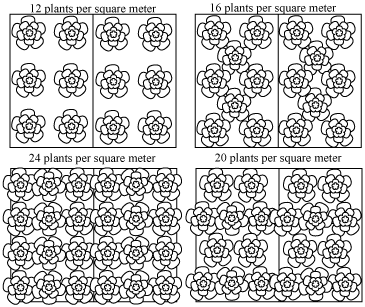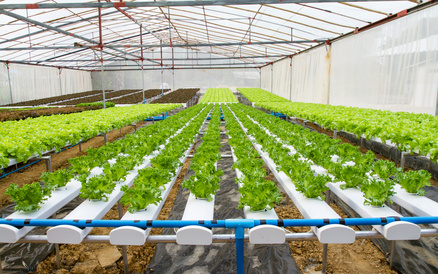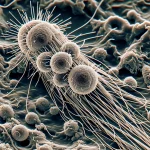Planting density of various vegetable crops in hydroponic systems
Planting density in bag culture systems
Pepper & tomato planting density influences yields, diseases and quality of the end product. Get it right the first time. Peppers are planted in the same density as tomatoes in hydroponic bag culture systems. Each plant should be 40 cm apart in the double rows, the double rows should be at least 1.5 m apart. Plants are planted 40-50 cm apart within the row. When using gravel culture with 1 m wide gullies, the plants should be planted 40 cm apart and 40 cm within the row.
Planting densities for peppers
It is important to note that planting at higher densities does not mean higher yields. The inverse is also true. Generally a pepper plant should provide at least 35 fruit per plant in a full growing season starting from planting date in early September and ending in the last weak of May. Local climate will influence the yields as well as fertilizer management etc. If above planting densities are used, there should be at least 30,000 plants per hectare (based on 0.4 m within row, 04 m in row and 1.5 m paths). It is not recommended to plant at higher densities since yields will not increase. Increasing plant density will decrease the fruit size. The ideal planting density using bag culture is 25,000 plants. This provides adequate aeration for the pepper plants which require well ventilated environment to grow optimally.
Planting densities for tomatoes
Generally a tomato plant should provide at least 10 kg fruit per plant in a full growing season starting from planting date in early September and ending in the last week of May. This provides for 38kg.m-2 per season (estimate includes paths). Increasing planting density will decrease size of fruits, but increase the number of fruits. Decreasing the planting density will increase size of fruits and decrease number of fruits. Local climate will influence the yields as well as fertilizer management. If above planting densities are used, there should be no more than 30,000 plants per hectare (based on 0.4m within row, 04m in row and 1.5m paths). It is not recommended to plant at higher densities since yields will not increase. The ideal planting density is between 22,000 and 25,000 plants per hectare. This provides adequate aeration for the tomato crop which require well ventilated environment to grow optimally.
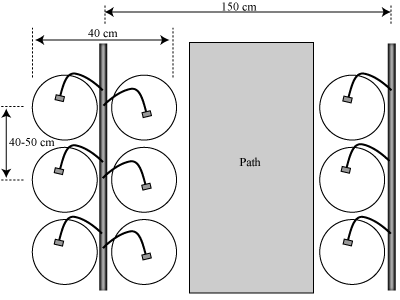
Planting density for green beans
Bean seed are sown directly into the growth bags or directly into the gravel. If a bag culture system is used, at least three seeds should be planted in each bag. Green beans are ideally suited for bag culture growing. The following procedure should be followed when preparing and sowing bean seed in hydroponic growth bags, which are filled with sawdust.
- Ensure that the growth medium is kept wet for at least a week before sowing
- Place a 2 cm layer of either fine sawdust or river sand on top of the rough growth medium inside the bag.
- Irrigate for 2 days until the top layer saturated
- Place the three bean seeds in the middle of the new top layer, each as far away from the other as possible but not closer than 30 mm from the side of the bag
- Irrigate regularly and check each day that the top layer does not dry out.
- Fasten trellising twine at the side of the bag closest to the seed.
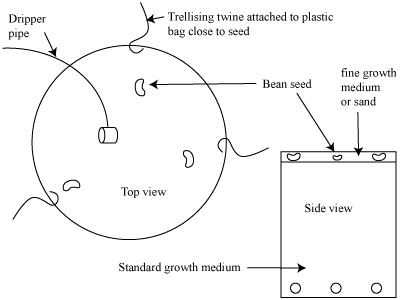
Planting densities of lettuce
Lettuce can be planted in a wide range of densities, unlike other crops that need to be trellised such as tomatoes, cucumbers and peppers. The final decision to select a specific density and planting pattern will depend on various factors such as:
- The type and variety of lettuce
- Climate of the area
- The required size of the plant at harvesting
- Spray equipment used to control pests and diseases
- Time of year when plants are planted
One could add other factors in such as economic pressure on the grower to grow as many plants per square meter in order to pay of his farm, the amount of risk the grower will take that he will lose more plants with high planting densities or personal preference. There are many that can be added, however the above list are the most important factors influencing the growers decision.
Type and variety will have a significant influence on planting density. The type of lettuce will depend on the growth habit (shape) of the leaves. Some types grow “vertically”, more upright, allowing higher planting densities and others have a more flat or “horizontal” growth habit, requiring a lower planting density. Within a lettuce type there are also differences, especially in the plants ability to cope with diseases and the environment. Some varieties, especially the latest types, have more resistance towards downy mildew, a major problem during cold humid periods. The more resistant the plant is the higher the planting density can be.
Climate of the area in which the plants are grown will have a significant influence on planting density. Areas which have a low relative humidity during colder periods, allow for higher planting densities than areas with high humidity in cold periods. High humidity increases the risk for downy mildew which is a major problem to control in high plant densities, especially plants that have a flat growth habit.
The size at which the plant is harvested has a significant influence how dens the plants can be planted. For instance, if a butter lettuce crop is sold as whole plants, the grower would like it to be as big as possible to obtain the maximum price. However if the leaves of the plant are harvested and packed in to pillow packs, the plant can be smaller when harvested thus allowing denser planting densities.
Spray equipment is critical to control plant disease in lettuce. If a back spray is the only equipment a grower has, it is best to keep planting densities low (at least below 16 plants/m²). If however the grower has access to a mist blower or fogger, higher densities will provide less risk since diseases can be controlled more effectively.
Time of the year plays an important role in the density. However, it would be naïve to recommend the optimum plant density for a particular variety throughout the year since a lot will also depend on the grower’s managerial ability to control diseases. Following a planting density without taking in consideration the grower’s strong and weak points in managing the farm would be irresponsible. In general, densities can be higher in winter than in summer. What the exact amount per square meter is must be determined by the grower himself. It is best to start with 16 plants/m², upon close monitoring of growth and disease infestation, the density should then be adjusted with the next planting/season.
